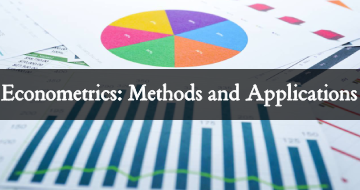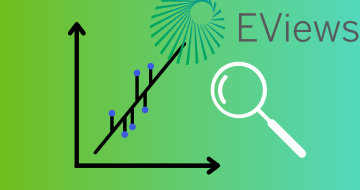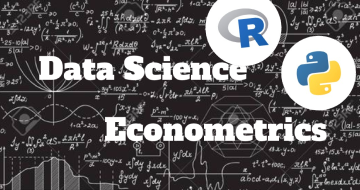IIRF Online > Finance & Accounting > Economics > Econometrics > Econometrics: Solved Questions and Mathematical Proofs
Econometrics: Solved Questions and Mathematical Proofs by Udemy
Step by step solutions to 60+ Econometrics Questions. Ideal for university students who are new to Econometrics.
Course Highlights
- Practice Questions - Simple and Multiple Linear Regression
- Mathematical Proofs - Simple Linear Regression
- Practice Questions - Functional Forms and Dummy Variables
- Practice Questions - Multicollinearity
- Practice Questions - Heteroscedasticity and Autocorrelation
- Feel much more confident in solving exam style questions
Skills you will learn!
Curriculum
5 Topics
List of Questions
Question 1 - p-value and Null Hypothesis
Question 2 - Which test statistic to use for hypothesis testing?
Question 3 - Power of Test
Question 4 - Interpretation of Confidence Interval
12 Topics
List of Questions
Question 1 - Estimation of intercept when slope coefficient is zero
Question 2 - Location of sample regression line
Question 3 - Regression doesn't imply causation
Question 4 - Calculate the value of intercept and slope estimator
Question 5 - Confidence IntervalInterpretation of slope coefficient & R-squared
Question 6 - Calculate OLS estimators standard error of regression & R-squared
Question 7 - What if expected value of the population error term is not zero?
Question 8 (Newly Added)
Question 9 (Newly Added)
Question 10 (Newly Added) - Working with R2 formulas
Share your experience
15 Topics
Derivation of Intercept's Estimator using Ordinary Least Squares Method
Derivation of Slope's Estimator using Ordinary Least Squares Method
(Optional Lecture) Another Method to Solve for Intercept and Slope's estimator
Different formulas to calculate Slope's estimator
Different formulas to calculate Slope's estimator (Continued)
Useful Results of OLS
Useful Results of OLS (Continued)
Assumptions of Classical Linear Regression Model (CLRM)
Assumptions of CLRM (Continued)
What is Gauss Markov Theorem?
Gauss Markov Theorem: Slope Estimator is Linear
Gauss Markov Theorem: Properties of new non-stochastic variable
Gauss Markov Theorem: Slope Estimator is Unbiased
Gauss Markov Theorem: Slope Estimator is Efficient
Gauss Markov Theorem: Slope Estimator is Efficient (Continued)
22 Topics
List of Questions
Question 1 - Relationship between adjusted R2 and R2
Question 2 - Does a high value of R2 means you have a good model?
Question 3 - Can adjusted R2 be negative?
Question 4 - Value of R2 on adding an insignificant and unimportant variable
Question 5 - R2 in regression through origin models
Question 6 - ANOVA Table and Adjusted R squared
Question 7 - ANOVA Table Test of Overall Significance and Adjusted R-Squared
Question 8 - Interpretation of coefficients and Test of Overall Significance
Question 9 - Interpretation of log-log model and Test of Overall Significance
Question 10 - Restricted Unrestricted Model and F-test
Question 11 - Joint Hypothesis Test and Interpretation of lin-log model
Question 12 - Working with log-log functional form and t-test
Question 13 - Slope and Elasticity of various functional forms
Question 14 - Hypothesis testing using the relationship between t and F
Question 15 - Correlation between fitted values and residuals
Question 16 - Numerator and Denominator Degrees of Freedom in F-test
Question 17 - Interpretation of slope coefficient in log-lin model
Question 18 - Interpretation of slope coefficient in lin-log model
Question 19 - Don't take 'logs' on the variables under this scenario
Question 20 (Newly Added) - Calculate value of t-test statistic
Question 21 (Newly Added) - Calculate value of F-test statistic
8 Topics
List of Questions
Question 1 - Basic Interpretation
Question 2 - Dummy variable trap
Question 3 - Dummy variable trap
Question 4 - Dummy variables for 4 quarters
Question 5 (Newly Added) - Dummy Variable Trap
Question 6 (Newly Added) - Interaction of a Dummy and a Quantitative Variable
Question 7 (Newly Added) - Working with Dummy Variables
5 Topics
List of Questions
Question 1 - Perfect Collinearity (Exact Linear Relationship) among regressors
Question 2 - Perfect Collinearity (Exact Linear Relationship) among regressors
Question 3 - Perfect Collinearity (Exact Linear Relationship) among regressors
Question 4 - High Multicollinearity
4 Topics
Question 1 - Consequences of Heteroscedasticity
Question 2 - White's test for Heteroscedasticity
Question 3 - Transform the regression equation to deal with Heteroscedasticity
Question 4 - Transform the regression equation to deal with Heteroscedasticity
6 Topics
Question 1 - Test 1st Order Autocorrelation (Durbin-Watson d-test)
Question 2 - Assumptions underlying Durbin Watson d-test
Question 3 - Test 1st Order Autocorrelation (Durbin-Watson d-test)
Question 4 - Presence of Positive Autocorrelation?
Question 5 - Test 1st Order Autocorrelation (Durbin-Watson d-test)
Question 6 - Testing for Autocorrelation - Breusch Godfrey Test
2 Topics
List of Questions (Multiple Choice Questions)
MCQ Solutions
11 Topics
Question 1
Question 2
Question 3
Question 4
Question 5
Question 6 - Transforming Dependent & Independent variable by adding a constant
Question 7 - Changing the values of dummy variable and statistical significance
Question 8: Covariance between sample error and independent variable
Question 9
Question 10
Question 11
1 Topic
Bonus Lecture

Econometrics: Solved Questions and Mathematical Proofs






